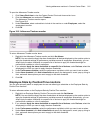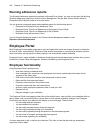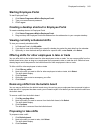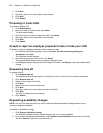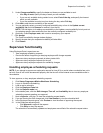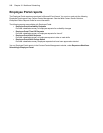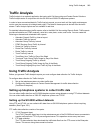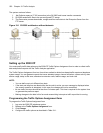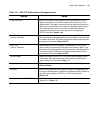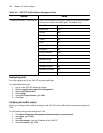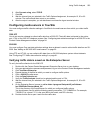Using Traffic Analysis 549
Traffic Analysis
Traffic Analysis is an optional application that works with Call Accounting and Contact Center Solutions.
Traffic Analysis works in conjunction with the SX-2000 and 3300 ICP telephone systems.
In order to have summarized data for Traffic Analysis reports you must wait until the nightly maintenance
routine runs the summary (at midnight each night). The data for these reports is derived from the traffic
stream. Traffic Analysis reports are not available in real-time.
For detailed information about traffic reports, refer to the Mitel Call Accounting Reports Guide. Traffic reports
provide call statistics on DTMF receivers, route lists, route plans, routes, and trunks. You can create the
following on-demand and scheduled traffic reports:
• Attendant Console Traffic by Interval report
• Attendant Traffic by Interval
• Attendant Group Traffic by Interval
• DTMF Receiver Group Traffic by Interval
• Route List Traffic by Interval
• Route Plan Traffic by Interval
• Route Traffic by Interval
• Trunk Traffic by Interval
• Trunk Busy Hour Traffic by Day of the Week
• Trunk and Trunk Group Traffic Usage by Day of the Week
• Trunk Group Outgoing Traffic by Interval
• Trunk Group Outgoing Traffic Usage by Day of the Week
• Trunk Group Outgoing Busy Hour Traffic by Day of the Week
Using Traffic Analysis
Before you generate Traffic Analysis reports you must configure data collection for Traffic Analysis.
To configure data collection for Traffic Analysis
1. Set up the telephone systems to collect traffic data
2. Configure the media servers in Contact Center Management for traffic data collection
(YourSite=>Enterprise)
Setting up telephone systems to collect traffic data
You can collect traffic data from an SX-2000 telephone system using datasets or using FTP without datasets.
You can collect traffic data from a 3300 ICP telephone system over TCP/IP.
Setting up the SX-2000 without datasets
Using FTP and VT100, you can collect traffic data from an SX-2000 telephone system without requiring
datasets. (See Figure 19-1.)
FTP traffic data collection consists of two parts:
1. VT100 Transport Agent
The VT100 Transport Agent logs in to the maintenance port of the SX-2000 and issues commands to
transfer traffic data via FTP to a pre-configured server. This operation occurs every two hours.
2. FTP data collection
The FTP data collection then downloads the traffic data files from the FTP server to the Enterprise
Server. This occurs during the summarize function.



